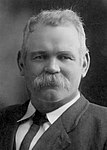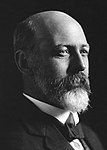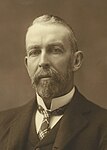The Australian states each elected three members of the Australian Senate at the 1903 federal election to serve a six-year term starting on 1 January 1904.
| |||||||||||||||||||||||||||||||||||||||||||||||||||||||||||||||||||||||||||||
19 of the 36 seats in the Senate 18 seats needed for a majority | |||||||||||||||||||||||||||||||||||||||||||||||||||||||||||||||||||||||||||||
|---|---|---|---|---|---|---|---|---|---|---|---|---|---|---|---|---|---|---|---|---|---|---|---|---|---|---|---|---|---|---|---|---|---|---|---|---|---|---|---|---|---|---|---|---|---|---|---|---|---|---|---|---|---|---|---|---|---|---|---|---|---|---|---|---|---|---|---|---|---|---|---|---|---|---|---|---|---|
| |||||||||||||||||||||||||||||||||||||||||||||||||||||||||||||||||||||||||||||
Australia
edit| Party | Votes | % | ± | Seats | |||
|---|---|---|---|---|---|---|---|
| Seats won |
Seats held |
Seat change | |||||
| Free Trade | 986,030 | 34.33 | −5.11 | 4 | 12 | 3 | |
| Labour | 784,859 | 27.33 | +13.83 | 3 | 8 | 4 | |
| Protectionist | 503,586 | 17.53 | −27.33 | 3 | 8 | 3 | |
| National Liberal Union | 136,727 | 4.76 | +4.76 | 0 | 0 | ||
| Socialist Labor | 69,769 | 2.43 | +1.41 | 0 | 0 | ||
| Revenue Tariff | 25,310 | 0.88 | +0.88 | 1 | 1 | 1 | |
| Independent | 365,851 | 12.74 | −8.60 | 1 | 1 | 1 | |
| Formal votes | 2,872,132 | ||||||
| Total | |||||||
| Registered voters / turnout | 1,893,586 | 46.86 | |||||
New South Wales
editEach elector voted for up to three candidates. Percentages refer to the number of voters rather than the number of votes.
| Party | Candidate | Votes | % | ±% | |
|---|---|---|---|---|---|
| Free Trade | John Neild (re-elected 1) | 192,987 | 61.6 | ||
| Free Trade | Edward Pulsford (re-elected 2) | 191,170 | 61.0 | ||
| Free Trade | John Gray (elected 3) | 188,860 | 60.3 | ||
| Labour | Arthur Griffith | 108,312 | 34.6 | ||
| Protectionist | Nathaniel Collins | 66,763 | 21.3 | ||
| Protectionist | John Cunneen | 60,200 | 19.2 | ||
| Socialist Labor | Andrew Thomson | 25,976 | 8.3 | ||
| Socialist Labor | James Moroney | 25924 | 8.3 | ||
| Independent | Henry Fletcher | 23,555 | 7.5 | ||
| Independent | Mary Bentley | 19,254 | 6.1 | ||
| Ind. Free Trade | Nellie Martel | 18,846 | 6.0 | ||
| Socialist Labor | Herbert Drake | 17,870 | 5.7 | ||
| Total formal votes | 939,717 313,239 voters |
95.2 | |||
| Informal votes | 15,740 | 4.8 | |||
| Turnout | 328,979 | 47.9 | |||
| Party total votes | |||||
| Free Trade | 573,017 | 61.0 | |||
| Protectionist | 126,963 | 13.5 | |||
| Labour | 108,312 | 11.5 | |||
| Socialist Labor | 69,770 | 7.4 | |||
| Independent | 61,655 | 6.6 | |||
Queensland
editEach elector voted for up to three candidates. Percentages refer to the number of voters rather than the number of votes.
| Party | Candidate | Votes | % | ±% | |
|---|---|---|---|---|---|
| Labour | Harry Turley (elected 1) | 66,074 | 55.1 | ||
| Labour | James Stewart (re-elected 2) | 64,077 | 53.5 | ||
| Labour | Thomas Givens (elected 3) | 62,088 | 51.8 | ||
| Liberal | Walter Tunbridge | 47,927 | 40.0 | ||
| Liberal | John Bartholomew | 47,081 | 39.2 | ||
| Liberal | John Murray | 41,719 | 34.8 | ||
| Ind. Protectionist | Thomas Glassey (defeated) | 30,720 | 25.6 | ||
| Total formal votes | 359,623 119,895 voters |
96.3 | |||
| Informal votes | 4,612 | 3.7 | |||
| Turnout | 124,507 | 54.8 | |||
| Party total votes | |||||
| Labour | 192,239 | 53.5 | |||
| Liberal | 136,664 | 38.0 | |||
| Independent | 30,720 | 8.5 | |||
South Australia
editEach elector voted for up to three candidates. Percentages refer to the number of voters rather than the number of votes.
| Party | Candidate | Votes | % | ±% | |
|---|---|---|---|---|---|
| Labour | Gregor McGregor (re-elected 1) | 31,082 | 58.0 | ||
| Labour | Robert Guthrie (elected 2) | 28,376 | 53.0 | ||
| Labour | William Story (elected 3) | 23,083 | 43.1 | ||
| Free Trade | David Charleston (defeated) | 22,499 | 42.0 | ||
| Free Trade | William Copley | 19,402 | 36.2 | ||
| Free Trade | Robert Caldwell | 19,400 | 36.2 | ||
| Independent | Crawford Vaughan | 8,595 | 16.0 | ||
| Independent | William Grasby | 8,294 | 15.5 | ||
| Total formal votes | 160,731 53,577 voters |
97.8 | |||
| Informal votes | 1,208 | 2.2 | |||
| Turnout | 53,577 | 32.4 | |||
| Party total votes | |||||
| Labour | 82,541 | 51.4 | |||
| Free Trade | 61,301 | 38.1 | |||
| Independent | 16,889 | 10.5 | |||
Tasmania
editEach elector voted for up to three candidates. Percentages refer to the number of voters rather than the number of votes.
| Party | Candidate | Votes | % | ±% | |
|---|---|---|---|---|---|
| Revenue Tariff | Henry Dobson (re-elected 1) | 17,979 | 50.6 | ||
| Free Trade | James Macfarlane (re-elected 2) | 15,796 | 44.4 | ||
| Protectionist | Edward Mulcahy (elected 3) | 12,762 | 35.9 | ||
| Protectionist | Cyril Cameron (defeated) | 12,094 | 34.0 | ||
| Labour | Milner Macmaster | 11,333 | 31.9 | ||
| Labour | Charles Metz | 9,776 | 27.5 | ||
| Labour | James Mahoney | 8,728 | 24.6 | ||
| Revenue Tariff | Stafford Bird | 7,331 | 20.6 | ||
| Free Trade | James Waldron | 6,776 | 19.1 | ||
| Free Trade | Edward Miles | 4,062 | 11.4 | ||
| Total formal votes | 106,637 35,546 voters |
96.1 | |||
| Informal votes | 1,441 | 3.9 | |||
| Turnout | 36,987 | 45.0 | |||
| Party total votes | |||||
| Labour | 29,837 | 28.0 | |||
| Free Trade | 26,634 | 25.0 | |||
| Revenue Tariff | 25,310 | 23.7 | |||
| Protectionist | 24,856 | 23.3 | |||
Victoria
editThere were four vacancies in Victoria due to the death of Sir Frederick Sargood. Robert Reid (Free Trade) had filled the seat in the interim, with the fourth senator elected serving the balance of Sargood's term ending on 31 December 1906. Each elector voted for up to four candidates. Percentages refer to the number of voters rather than the number of votes.
Western Australia
editEach elector voted for up to three candidates. Percentages refer to the number of voters rather than the number of votes.
| Party | Candidate | Votes | % | ±% | |
|---|---|---|---|---|---|
| Labour | Hugh de Largie (re-elected 1) | 19,644 | 63.1 | ||
| Labour | George Henderson (elected 2) | 18,414 | 59.1 | ||
| Labour | John Croft (elected 3) | 17,464 | 56.1 | ||
| Free Trade | Henry Saunders (defeated) | 9,979 | 32.0 | ||
| Protectionist | Michael Cavanagh | 8,892 | 28.5 | ||
| Free Trade | William Martin | 7,109 | 22.8 | ||
| Free Trade | Herbert Preston | 6,126 | 19.7 | ||
| Protectionist | Samuel Moore | 5,818 | 18.7 | ||
| Total formal votes | 93,446 ~31,000 voters |
~98 | |||
| Informal votes | 2,001 | ~2 | |||
| Turnout | ~33000 | ~27 | |||
| Party total votes | |||||
| Labour | 55,522 | 59.4 | |||
| Free Trade | 23,214 | 24.8 | |||
| Protectionist | 14,710 | 15.7 | |||
See also
editNotes
edit- ^ William Trenwith, was a former trade union official and leader of the Victorian Labour Party who was an independent because of his refusal to pledge to vote as directed by the Labour Party.[7]
References
edit- ^ "The Senate Poll: complete figures". The Sydney Morning Herald. 4 January 1904. p. 7. Retrieved 13 June 2021 – via Trove.
- ^ "Polling for Senators: declaration of results". The Telegraph. Brisbane. 20 January 1904. p. 2. Retrieved 13 June 2021 – via Trove.
- ^ Carr, Adam. "1903 Senate South Australia". Psephos.
- ^ "The Senate: declaration of the Poll". The Mercury. Hobart. 31 December 1903. p. 3. Retrieved 13 June 2021 – via Trove.
- ^ Carr, Adam. "1903 Senate Tasmania". Psephos.
- ^ Carr, Adam. "1903 Senate Victoria". Psephos.
- ^ Scates, B. "Trenwith, William Arthur (Billy) (1846–1925)". Australian Dictionary of Biography. Canberra: National Centre of Biography, Australian National University. ISBN 978-0-522-84459-7. ISSN 1833-7538. OCLC 70677943. Retrieved 25 February 2017.
- ^ Carr, Adam. "1903 Senate Western Australia". Psephos.



